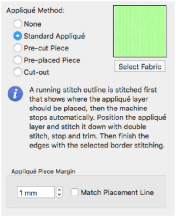
Appliqué Method
Choose a method for placing and securing the appliqué fabric. Select the appliqué method before or after creating an area or line. Choose from:
-
None
-
Standard Appliqué
-
Pre-cut Piece
-
Pre-placed Piece
-
Cut-out
Satin line is typically used as the border for an appliqué area. Alternatively, triple stitch or a motif line may be used for a hand-embroidered effect.
Stitch a running line to show where appliqué fabric should be placed, then stop to position the fabric. Stitch down the appliqué fabric with double stitch, then stop so the fabric may be trimmed. Finish the edges with the selected border stitching.
Use a pre-cut appliqué piece; created, for example, using an automatic cutter or cutwork needles.
Stitch a running line to show where the pre-cut appliqué piece should be placed, then stop to position the appliqué piece. Stitch down the appliqué piece with double stitch, then finish the edges with the selected border stitching.
Place the appliqué fabric before stitching.
Place the appliqué layer in position, then stitch down the appliqué fabric with double stitch. Stop so the fabric may be trimmed. Finish the edges with the selected border stitching.
Use the appliqué placement line as a guide to where the fabric should be cut; for example for reverse appliqué.
Stitch a double stitch line. Stop so the fabric may be cut to form a hole defined by the stitched outline. Finish the edges with the selected border stitching.
Select Fabric
Select a fabric in the Appliqué Selection dialog. See Appliqué Selection.
Appliqué Piece Margin
Set the margin for appliqué placement relative to the drawn border shape (-10mm to 10mm - initial value is 1.0mm).
Note: Use a positive value when trimming the appliqué fabric before the border is stitched, for example with Standard Appliqué and Pre-placed Appliqué. A negative value is recommended for cut-out and reverse appliqué.
Match Placement Line
Adjust the position of the first running stitch line for either Standard Appliqué or Pre-cut Piece so that it matches the outline of the appliqué piece after the Appliqué Piece Margin has been applied.
Note: This may be useful for precise positioning of appliqué pieces that have been pre-cut with an automated cutter, to ensure the placement line is visible.